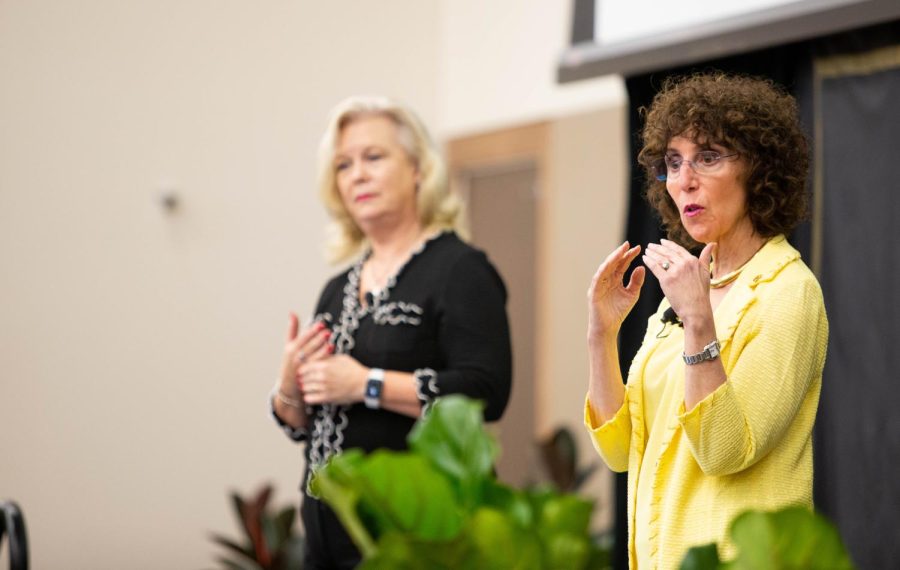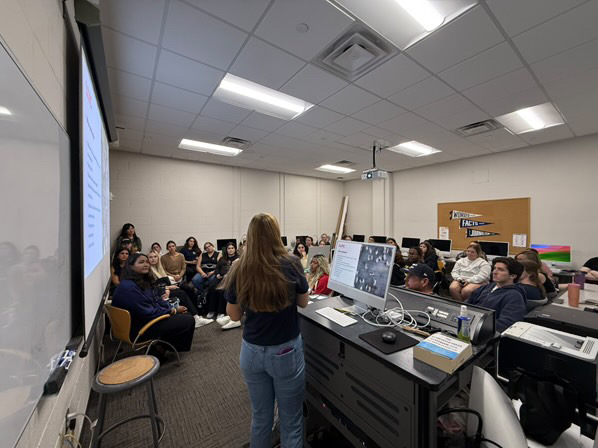President Pescovitz, Provost Rios-Ellis answer The Post’s questions about future of OU
Photo courtesy of John McTaggart/Oakland University
President Pescovitz and Provost Rios-Ellis on stage during last Wednesday’s State of Academic Affairs Address. Following the event, they sat down with The Post to answer some questions for the campus community.
Following last Wednesday’s State of Academic Affairs Address, President Ora Hirsch Pescovitz and Executive Vice President for Academic Affairs and Provost Britt Rios-Ellis sat down for an interview with The Post to answer questions about the future of OU. This article outlines and provides context to that discussion.
The State of Academic Affairs Address was a mix of celebrating OU’s successes in the pandemic era, while also acknowledging challenges facing the university moving forward. The main challenges being achieving financial policy decisions that allow OU to balance its budget, without compromising its academic mission or appeal to students.
OU’s enrollment is down approximately 9% in the current fiscal year and is expected to decrease further over the next five years. OU is the least funded of Michigan’s 15 public universities, receiving only about $3,000 per student, and is therefore heavily reliant on enrollment and the funds received from tuition dollars.
During the address, $8.9 million in cuts to OU’s base budget were announced as part of offsetting the financial impact of decreased enrollment. Similarly, Pescovitz confirmed that tuition rates will likely be increased over the summer.
When asked exactly how much that increase in tuition would be Pescovitz said, “We don’t know. What I committed to … What I said in my presentation is the governor has a cap [where tuition can’t be increased by more than 5% at once] … It’ll be below that cap. I suspect there will be some increase.”
Last summer, tuition was increased 4.2% by the Board of Trustees (BOT). There was a tuition rate freeze for one year due to the pandemic, but otherwise an approximate 4% increase in tuition rates has been standard in recent years. It is worth noting that, while tuition will likely increase, the university recently embraced faculty and student efforts in making course materials more affordable.
Concerning state funding, Pescovitz revealed during the address the optimism that OU leaders have concerning Governor Gretchen Whitmer’s proposed budget and the university’s Strive for 45 campaign. That campaign was launched to help lobby Lansing in favor of raising OU’s funding per student to $4,500. If Whitmer’s current budget proposal is approved OU could be on track to achieve that goal over the next four years, which would be hugely beneficial for the university.
“The things that were in the budget for this year that she has proposed [were a] 5%, increase for base [funding] for one time, and to go from $3,000 to $3,500 this year,” Pescovitz said. “So if [that] happened, that would be amazing. We are not expecting [that] … We’re expecting 70% of that … That was the assumption we made in our budget prediction. So we don’t know exactly what’s going to happen, but I actually predict that we’ll get the $3,500.”
The other component of the university acquiring funds via tuition and state funding is keeping enrollment as high as possible. In order to make sure that OU attracts and retains students going forward, during the address Provost Rios-Ellis outlined the university’s focus on strengthening diversity, equity and inclusion and expanding academic opportunities with new graduate studies and specialized major and minor programs.
There have been concerns from faculty about changes to course occupancy rules, and a new reported 80% enrollment threshold requirement for courses to proceed in the semester that they’re scheduled. The main concern being that this requirement could jeopardize a number of course offerings in the College of Arts and Sciences, including new specialized majors and minors. Rios-Ellis addressed those concerns.
“We’re trying to be really sensitive around and careful around budget cuts that we’ve had to make,” Rios-Ellis said. “ … So in order to do that, we really have to take a critical look at it are we offering undergraduate courses with three or four people? … Most universities have an enrollment level at which classes have to get to … We want to have 20 to 25 students in each course. That doesn’t mean that we would cancel the course if a chair comes to a dean, and then comes to us and says, ‘Hey, we’ve got eight students in this class, but all eight need this class to graduate, we’re gonna hold that class.’ We’re not going to cancel that class. There’s no way we could do that. But we have to have a consciousness of really trying to create ways in which we can achieve a more optimal enrollment per class, or eventually we would have to make larger, more severe cuts and we don’t want to do that.”
When asked to confirm that 80% enrollment threshold requirement number Rios-Ellis said, “We established a policy, but what we said when we established the policy was, ‘We’ll work with everyone.’”
Another issue touched on during the address, that students and faculty are concerned about, is the issue of a lack of space on campus. There are several ongoing campus construction projects that will expand space for the campus community; what still hasn’t been finalized is the recently reported university plans for an acquisition of what was formerly the Baker College Auburn Hills campus.
Pescovitz was asked about progress on making that deal and the reported $8.15 million price tag for acquiring the facility — spending that the BOT would have to approve.
“We’re very interested in it, but we have to do due diligence on what it would actually cost to be in there,” Pescovitz said. “[$8.15 million] was the purchase price, but to actually be in there, and there would be renovations, we don’t know the full price of the renovations. It could cost substantially more to do all the renovations that would be necessary … It’s in a very good location. It has very good classroom facilities for the kinds of things that we are looking for, for many of the kinds of classrooms that we need … It has a lot of terrific opportunities. But we don’t have enough money right now to fully pay for it. So we’re looking for other sources of support. If we can get enough to cover the bulk of what it would cost then it becomes a no brainer.”
Another theme of the address was facilitating collaboration on campus and getting faculty, students and staff to buy in and support university leadership’s vision for the future of OU. A major story this year has been the divide between Oakland University’s Chapter of the American Association of University Professors (OU AAUP) faculty members and the upper administration following last summer’s contentious faculty contract negotiations.
The recently announced Faculty Board Liaison Task Force (FBLTF) has the potential to be a significant step in the right direction for improving the relationship between OU AAUP faculty and OU’s upper-administration. The task force’s first scheduled meeting is April 11. Pescovitz shared her thoughts heading into that meeting.
“There’s been a hunger for people to have an opportunity to just get to know each other,” Pescovitz said. “I’m well aware of the fact that there’s been a sense that there hasn’t been an adequate amount of opportunity for communication … [FBLTF is] a great opportunity for the [BOT] to get to know the faculty leaders here.”
When the FBLTF was first announced there was some skepticism from faculty, especially since OU AAUP’s proposed faculty liaison plan was denied by the BOT, about how sincere the upper administration is being with efforts to repair relations. Pescovitz acknowledged those concerns.
“Every task force that I have charged has been effective in my career,” Pescovitz said. “ … A lot of the tension [between the university and faculty] had to do with the contract negotiations … By improving communications now, we can set the stage so that we will have hopefully smoother negotiations next time around. And that’s really important to us. We want to have better lines of communication.”
One impact that the COVID-19 pandemic has had on the university that was specifically touched upon during the address is “The Great Resignation” — the phenomenon of people migrating away from their workplaces to pursue other opportunities since the beginning of the pandemic.
On one hand, the university sees The Great Resignation as an opportunity to attract individuals interested in returning to higher education, but on the other hand OU could face difficulties in attracting and retaining talented staff. President Pescovitz touched upon what these changes could mean for OU going forward.
“Are we losing some of our best people? That may happen, that would be unfortunate, but some of that re-sizing may be okay for an institution with a certain amount of declining enrollment,” Pescovitz said. “ … We certainly don’t want that to happen to an excessive degree. And we are very enthusiastic and excited about our future … In spite of the 9% decline in enrollment that we [addressed] today because we don’t think that the sky is falling … Will there be shifts in faculty? There will be some, but I think we have to put it in perspective and say that … Some of that is the natural consequence of turnover that happens.”









Anon • Apr 5, 2022 at 1:14 PM
Serious question – why is there no talk of “resizing” OU’s administration? We have more VPs than MSU, and countless other superfluous administrators. It’s unconscionable to raise tuition while sustaining such an excessive administrative class. And is it appropriate for a public institution to dispense vehicle stipends to dozens or executives while thousands of our students face acute economic insecurity?
anon • Apr 5, 2022 at 1:43 PM
I assume you mean “down”sizing, because the provost already has “resized” her office; she doubled its size. I think most would agree that with maybe one exception, it’s been a total disaster. See below comment about the bungled rollout of the 80% program. That was the work of one of her new additions. That person is still there, getting well paid, and we have to assume searching for the next project. This is but one example of a long list of failed policies and rollouts (ask somebody about the failure that was the consulting firm hired to help with Advanced OU….paid silly money for their work, they were incompetent and we got nothing out of it….no consequences). Provost keeps telling us she is going to fix all these problems at OU, but at the end of the day, they can’t keep head above water long enough to have basic conversations about simple tasks like right-sizing courses and how to attract more students.. Far as I can tell, they keep messing it all up and then dumping it on the one competent assoc. provost to fix. Just put her in charge and save the headaches.
JustReplying • Apr 5, 2022 at 10:53 AM
I am very pleased that we have strong leadership at OU and now we are able to get access to their vision, progress, and plans for future growth of the university and its community. We might agree or not in the vision of our leadership according to our personal views or interest, however, like in any other organization the leadership has a panoramic view to analyze and make decision, not a narrow and bias view that everyone else have.
At least now, we are able to see their goals and directions, so I applaud both Dr Pescovitz and Dr. Rios-Ellis in their leadership.
Anonymous • Apr 5, 2022 at 12:38 PM
I don’t see much evidence in this story, or elsewhere, that President Pescovitz and Provost Rios-Ellis have “panoramic” perspectives. They seem to mean well, but their “vision” and “plans” seem to consist of little more than tired buzzwords and self-serving narratives.
Consider President Pescovitz’s reply to the student’s question about the faculty liaison proposal. Rather than answer the question, she celebrated herself: “Every task force that I have charged has been effective in my career.” Notice how quickly President Pescovitz skirts substance in favor of hubristic autobiography. (I’m surprised we didn’t also hear about the one time she met MLK!)
I am willing to admit that I have a “narrow and bias [sic]” view — doesn’t everyone? — but at least I can see that our Emperors have no clothes. People who work in Wilson Hall may want to question whether anyone outside of their bubble takes the Pescovitz cult of personality seriously.
Just replying to JustReplying • Apr 6, 2022 at 10:59 PM
The goals and directions of this “leadership” became crystal clear during negotiations with the faculty and other unions. The faculty negotiations led to a strike, a humiliating contract, the promotion of Cunningham, and a retaliatory lawsuit against AAUP. So, keep applauding the propaganda. I will say it repeatedly: the difference between this “leadership” and the Russian government is only quantitative – not qualitative. Abusers don’t stop. Narcissists and psychopaths don’t change. Liars don’t become truth-tellers. It is time to start using the brain and blot out delusional thinking.
Anonymous • Apr 5, 2022 at 10:19 AM
I am extremely disappointed with the message posted on this forum attacking President Pescovitz and Provost Rios-Ellis, both of which in my opinion are great asset to the University. One can understand the challenge of their job in the background of ongoing COVID and a war on Europe. These have adversely impacted both the student enrollment and the financial status of not only OU, but institutions like us all across the country. Both the President and the Provost have exceptional record of accomplishments, which spearheaded their recruitment to their respective positions at OU. Being a senior faculty in STEM department, both President Pescovitz and Provost Rios-Ellis have been extremely supportive of the faculty and various initiatives to promote research and funding opportunities. They both have been very approachable, which is a pleasant and welcoming change from the previous administration. The former OUWB Dean did not foster any collaborative efforts with accomplished biomedical faculty members at OU. This significantly impacted the research in both units in a negative manner. I have spent the past 2 decades at OU, and this is the first time we have had 2 women leading the helm. In this regard, I am saddened to see these nasty comments made against our very skilled and talented leaders. Perhaps, this forum is reflective of the undercurrent of rampant sexism that unfortunately still exists at OU.
anon • Apr 5, 2022 at 12:34 PM
Neutral observer here, but I don’t see a link between the leadership of OU and the ongoing war in Ukraine. I also don’t see how that war has impacted OUs financial status or admissions numbers. The financial issues faced by OU for the past several years have been long in the making. COVID certainly made it worse, but war in Europe….we would need evidence for that claim. I’m not taking a position on their leadership, but I don’t think it’s immediately unfair to criticize them because they have led during COVID and during a war in Eastern Europe.
Chelsea B. • Apr 5, 2022 at 1:05 PM
Seriously? You think that this is what leadership looks like?
A nearly 10% drop in enrollment, with no acknowledgement whatsoever that the drop is due in large part to her own policies and actions, is the *opposite* of leadership. She is running this university into the ground while making as much money off it as she can for as long as she can get away with it. She is no leader, she is a profiteer.
James J. • Apr 5, 2022 at 1:20 PM
Ora’s communication team working overtime to spread the talking points, I see. Bless.
JustAsking • Apr 5, 2022 at 8:13 AM
Does “resizing of faculty” mean we won’t be hiring the provost’s husband this coming year as a paid consultant in addition to his regular faculty position?
anon • Apr 5, 2022 at 8:11 AM
Love the humility
“Every task force that I have charged has been effective in my career.”
It’s like watching the covid videos all over again.
Also the 80% thing failed because Rios-Ellis assigned it to her most incompetent associate provost, who proceeded to totally screw it up with absurd ideas about how things should be done. Now the competent one has to clean up the mess.
anon • Apr 4, 2022 at 10:40 PM
Russian propaganda should hire Pescovitz and Rios-Ellis.